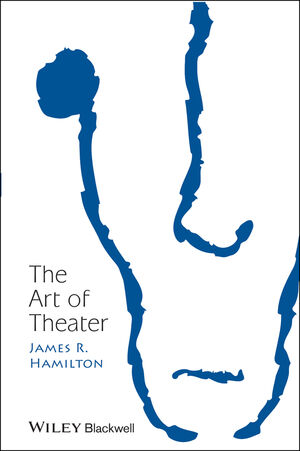The Art of TheaterISBN: 978-1-4051-1353-3
Hardcover
244 pages
July 2007, Wiley-Blackwell
 This is a Print-on-Demand title. It will be printed specifically to fill your order. Please allow an additional 10-15 days delivery time. The book is not returnable.
|
||||||
Part I: The Basics:.
1. The Emergence of the Art of Theater: Background and History.
1.1 The Backstory: 1850s to 1950s.
1.2 The Decisive Influences: Brecht, Artaud, Grotowski.
1.3 The Decisive Years: 1961 to 1985.
1.4 The Final Threads: Absorption of New Practices into the Profession and the Academy.
2. Theatrical Performance is an Independent Form of Art.
2.1 Theatrical Performance as Radically Independent of Literature.
2.2 Theatrical Performance as a Form of Art.
3. Methods and Constraints.
3.1 Idealized Cases that Help Focus on Features Needing Analysis.
3.2 Three General Facts about Theatrical Performances and the Constraints they Impose on any Successful Account of Theatrical Performances.
4. Theatrical Enactment: The Guiding Intuitions.
4.1 Enactment: Something Spectators and Performers do.
4.2 The Crucial Concept: “Attending to Another”.
4.3 What it is to “Occasion” Responses.
4.4 Audience Responses: Willing Suspension of Disbelief, Acquired Beliefs, or Acquired Abilities?.
4.5 Relativizing the Account by Narrowing its Scope to Narrative Performances.
Part II: The Independence of Theatrical Performance:.
5. Basic Theatrical Understanding.
5.1 Minimal General Success Conditions for Basic Theatrical Understanding.
5.2 Physical and Affective Responses of Audiences as Non-Discursive Evidence of Understanding.
5.3 The Success Conditions for Basic Theatrical Understanding Met by Moment-to-Moment Apprehension of Performances.
5.4 “Immediate Objects,” “Developed Objects,” and “Cogency”.
5.5 Objects of Understanding having Complex Structures.
5.6 Generalizing Beyond Plays.
5.7 The Problem of “Cognitive Uniformity”.
6. The mechanics of basic theatrical understanding.
6.1 The “Feature-Salience” Model of Spectator Convergence on the Same Characteristics.
6.2 What it is to Respond to a Feature as Salient for Some Characteristics or a Set of Facts.
6.3 A Thin Common Knowledge Requirement.
6.4 A Plausibly Thickened Common Knowledge Requirement.
6.5 The Feature-Salience Model, “Reader-Response Theory,” and “Intentionalism”.
6.6 Generalizing the Salience Mechanism to Encompass Non-Narrative Performances.
6.7 Some Important Benefits of the Feature-Salience Model: Double-Focus, Slippage, “Character Power,” and the Materiality of the Means of Performance.
6.8 The Feature-Salience Model and Explaining How Basic Theatrical Understanding Occurs.
7. What Audiences See.
7.1 Identifying Characters, Events, and Other Objects in Narrative Performances.
7.2 Re-identification of Characters and Other Objects in Narrative Performances.
7.3 The Special Nature of Theatrical (Uses of) Space: Performances and Performance Space.
7.4 Cross-Performance Re-identification.
7.5 Identifying and Re-identifying Objects in Non-Narrative Performances.
7.6 Added Benefits of the Demonstrative and Recognition-Based Approach to Identification and Re-identification.
7.7 Theatrical Performance as a Fully Independent Practice.
Part III: The Art of Theatrical Performance:.
8. Deeper Theatrical Understanding.
8.1 General Success Conditions for Deeper Theatrical Understanding.
8.2 More Precise Success Conditions: Two Kinds of Deeper Understanding.
8.3 Some Puzzles about the Relation Between Understanding What is Performed and Understanding How it is Performed.
8.4 Deeper Theatrical Understanding and Full Appreciation of a Theatrical Performance.
9. What Performers Do.
9.1 What Performers Do and What Audiences Can Know.
9.2 The Features of Performers and Choices That Performers Make.
9.3 Theatrical Conventions as Sequences of Features having Specific “Weight”.
9.4 What is Involved in Reference to Theatrical Styles.
9.5 More about Styles, as Produced and as Grasped.
9.6 Grasp of Theatrical Style and Deeper Theatrical Understanding.
10. Interpretive Grasp of Theatrical Performances.
10.1 Success Conditions for Interpreting What is Performed and Interpreting How it is Performed.
10.2 Eschewing Theories of “Work Meaning”.
10.3 Interpretation and Significance.
10.4 Interpreting Performers.
11. Full Appreciation of a Theatrical Performance.
11.1 The Case of the Culturally Lethargic Company.
11.2 Broader Implications of the CLC Problem.
11.3 The “Imputationalist” Solution.
11.4 Solving the CLC Problem Without Resorting to Imputationalism.
11.5 Full Appreciation of a Theatrical Performance and the Detection of Theatrical Failures.
Epilogue.
A. The Idea of a Tradition and Tradition-Defining Constraints.
B. Constraints Derived from Origins in Written Texts.
C. What Really Constrains Performances in the Text-Based Tradition.
D. The Myth of “Of”.
Glossary.
Index



